2021
Posted November 17, 2021
2022 Gulf Coast Energy Outlook Launched Nov. 17
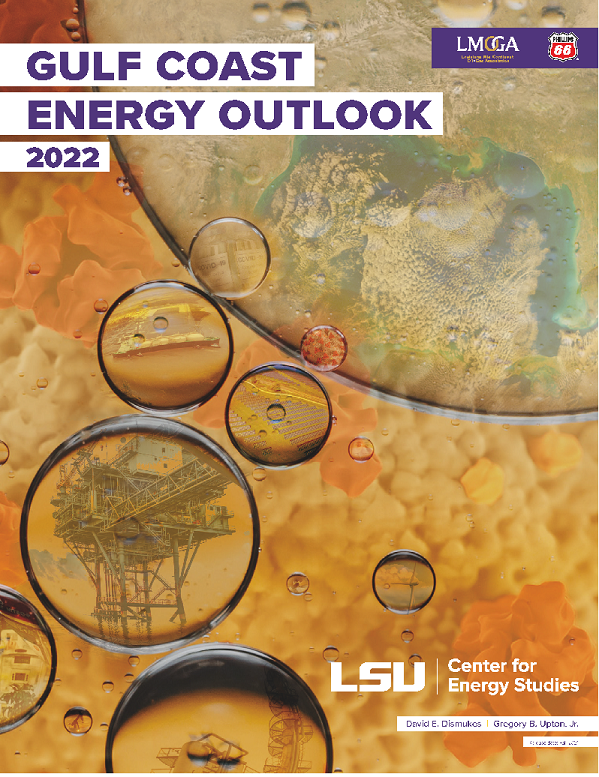 On November 17, 2021, the LSU Center for Energy Studies released the 2022 edition
of the Gulf Coast Energy Outlook (GCEO). As in previous years, this fifth edition
of the GCEO provides a comprehensive overview of the Gulf Coast region’s energy industry
outlook for the upcoming year. David E. Dismukes, executive director and professor,
and Greg Upton, associate professor, LSU Center for Energy Studies, authored the report.
On November 17, 2021, the LSU Center for Energy Studies released the 2022 edition
of the Gulf Coast Energy Outlook (GCEO). As in previous years, this fifth edition
of the GCEO provides a comprehensive overview of the Gulf Coast region’s energy industry
outlook for the upcoming year. David E. Dismukes, executive director and professor,
and Greg Upton, associate professor, LSU Center for Energy Studies, authored the report.
Last year’s GCEO addressed COVID-19-related uncertainties and how short-term recovery might evolve. The 2022 GCEO addresses several medium- to longer-term recovery issues, including whether temporary operational adjustments implemented by businesses will persist in a post-pandemic world. The report also considers the impacts of the 2020 and 2021 hurricane seasons.
Findings include
- U.S. crude oil production is currently below pre-pandemic levels, while natural gas supplies have exceeded pre-pandemic levels. Both oil and gas production are anticipated to increase in the future.
- Global crude oil demand growth, along with tight supplies and continued OPEC+ discipline, has put upward pressure on oil prices. Oil prices are anticipated to fall in coming years, converging to approximately $58 per barrel.
- While decarbonization initiatives may lead to near-term challenges for Gulf Coast industrial expansion, they also create opportunities for continued regional capital investment, as manufacturing industries develop products historically derived from fossil fuels with lower, or net zero, greenhouse gas emissions.
- Since 2013, U.S. and Gulf Coast power generation-related greenhouse gas emissions are down 20.7 percent and 15.8 percent, respectively, due in part to development of renewable energy and thermal efficiency gains by the region’s utilities.
- The 2022 GCEO identifies $155 billion in capital development potential through 2029, with liquefied natural gas (LNG) investments making up over 40 percent of this potential. The relative shift in potential capital investments away from chemical industry activities and toward LNG export facilities is expected to continue into the near future.
- Much like last year, long-run energy demand growth is expected to lead to increased U.S. energy exports, especially to the growing developing world.
- Texas and Louisiana are anticipated to reach new highs in refining and chemical manufacturing employment over the forecast time horizon, which extends through the end of 2024.
Posted November 3, 2021
2022 Gulf Coast Energy Outlook Zoom Webinar Nov. 17
The LSU Center for Energy Studies will host the 2022 Gulf Coast Energy Outlook (GCEO) Zoom Webinar on Wednesday, Nov. 17, 2021, 10 a.m. -11 a.m. The virtual event is free but requires registration.
The webinar will be presented by 2022 GCEO authors David E. Dismukes, executive director and professor, and Gregory B. Upton, Jr., associate professor-research, LSU Center for Energy Studies.
As in previous years, this fifth edition of the GCEO provides a comprehensive overview of the Gulf Coast region’s energy industry outlook for the upcoming year. Topics include
• outlook for crude oil and natural gas prices;
• changes in store for crude oil and natural gas drilling;
• energy and industrial capital investment for the region;
• industry’s responses to COVID-19 and whether those will persist into a post-pandemic
world;
• whether the fundamental relationships between energy consumption and economic activity
have changed as a result of the global pandemic;
• how offshore activity might be impacted by leasing restrictions;
• ways in which the 2020 and 2021 hurricane seasons impacted regional energy infrastructure
investments;
• risks that new trade policies with China might pose for Gulf Coast energy production
and exports.
Note: This live event will not be captioned. Please contact mpinsonn@lsu.edu by November 8 should you require individual digital accommodations.
Posted October 28, 2021
Center for Energy Studies Releases Louisiana 2021 Greenhouse Gas Inventory
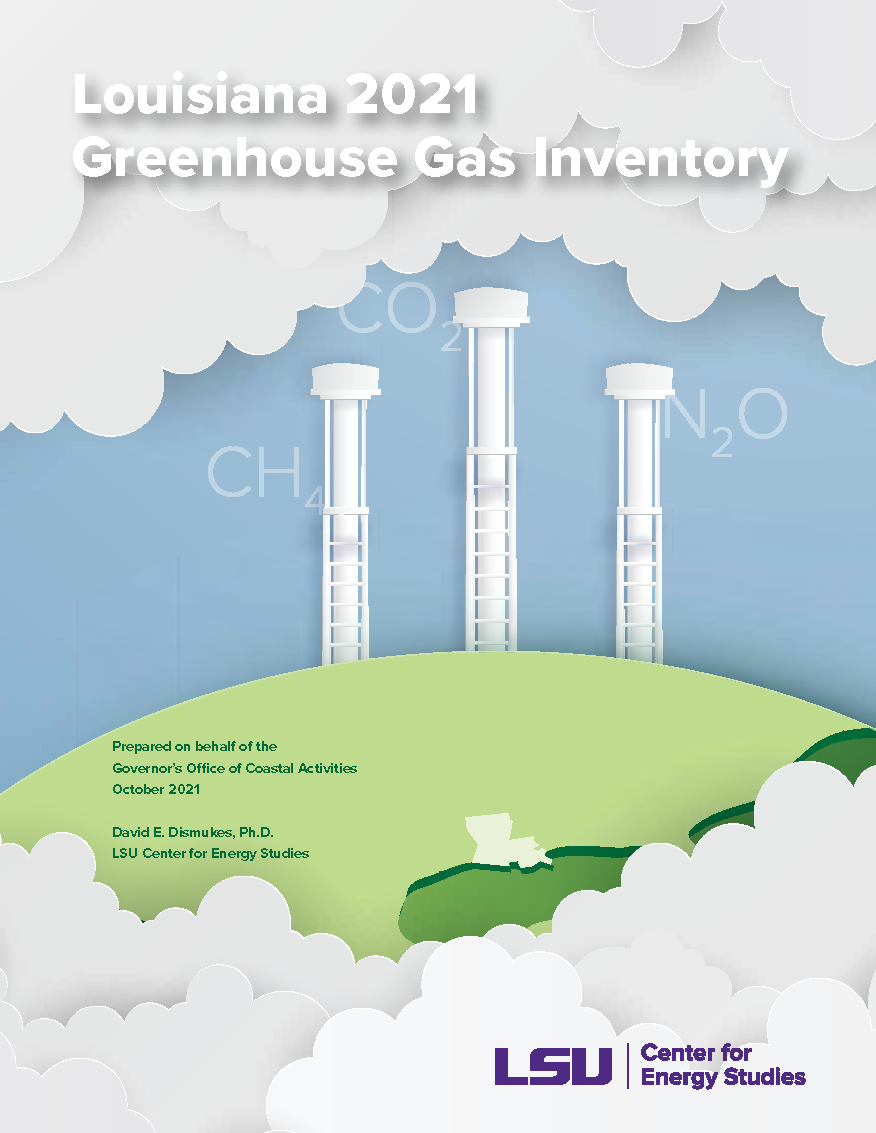 In the new Louisiana 2021 Greenhouse Gas Inventory, LSU Center for Energy Studies
(CES) Executive Director and Professor David E. Dismukes provides quantitative estimates
of the state’s greenhouse gas (GHG) emissions by economic sector. The report, an update
of the state GHG inventory conducted by CES in 1997 and 2010, was requested by the
Louisiana Governor’s Office of Coastal Activities and will serve as a key data tool
for the governor’s Climate Initiatives Task Force (CTF) as it considers the implications
that climate change and greenhouse gas (GHG) emissions have for the Louisiana economy
and environment.
In the new Louisiana 2021 Greenhouse Gas Inventory, LSU Center for Energy Studies
(CES) Executive Director and Professor David E. Dismukes provides quantitative estimates
of the state’s greenhouse gas (GHG) emissions by economic sector. The report, an update
of the state GHG inventory conducted by CES in 1997 and 2010, was requested by the
Louisiana Governor’s Office of Coastal Activities and will serve as a key data tool
for the governor’s Climate Initiatives Task Force (CTF) as it considers the implications
that climate change and greenhouse gas (GHG) emissions have for the Louisiana economy
and environment.
For the report, Dismukes uses methodologies and modeling established by the Environmental Protection Agency and follows guidelines set by the Intergovernmental Panel on Climate Change. The “cross-sectional” analysis, or snapshot, in time identifies where each major Louisiana economic sector stands in terms of its GHG emissions. Dismukes describes the inventory estimation process as a “top-down” analysis, as it estimates emissions across broad economic sectors and activities.
Throughout the investigative process, Dismukes worked with the Office of the Governor, various stakeholders, and the CTF Scientific Advisory Group to identify and estimate carbon emission sources and sinks in Louisiana. The report provides estimates of GHG emissions by activity type, economic sector, and GHG pollutant type, and estimates all three across a broad time period, 2000-2018.
Major findings include:
- Louisiana has a relatively high level of greenhouse gas emissions for its population size and GDP. The state’s share of total U.S. GHG emissions has hovered around 4.1 percent to 4.2 percent (1990-2018).
- U.S. and Louisiana total GHG emissions that arise from the combustion of fossil fuels have been decreasing since 2000.
- The trend in GHG emissions from the residential and commercial sectors of the Louisiana economy has been relatively consistent since 2000, with the combustion of fossil fuels as the main source.
- Louisiana’s transport-related GHG emission trends have decreased since 2000, likely due to increased vehicle fuel efficiencies, as well as an increase in alternative-fueled vehicles.
- Louisiana’s industrial GHG emissions have steadily increased since 2000, due to the expansion of industrial activity in the state during the past few years.
- The GHG emission trends from Louisiana’s power generation have seen the most improvement of any sector, particularly after 2010.
- Land use, particularly increasing forest area, can serve as a “sink” for sequestering Louisiana’s carbon emissions. Louisiana’s large forested lands, particularly in the northern part of the state, provide considerable negative emission resources.
- CO2 and methane (CH4) are the two largest pollutants produced by the oil and gas industry. Methane-related emissions have decreased as a result of decreased activity in that sector.
- Over 92 percent of all Louisiana GHG emissions (as of 2018) are CO2, with methane accounting for 4.3 percent, and N2O accounting for 2.13 percent.
- While U.S. GHG emissions are heavily concentrated in power generation and transportation, Louisiana’s are highly concentrated in industry; therefore, decarbonization of industry must be the predominate focus of attention for Louisiana policy makers in meeting the state’s future GHG emission goals.
Posted September 29, 2021
New White Paper Examines Pandemic-related Transportation Trends
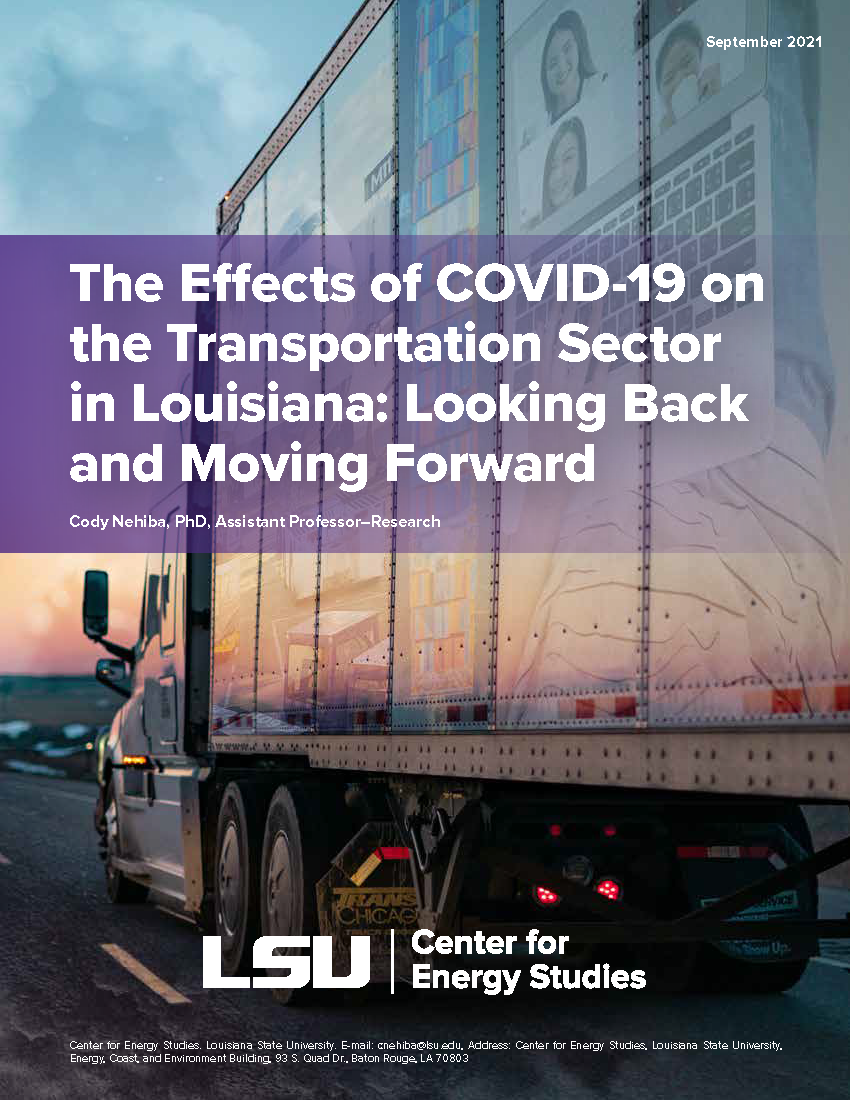 The global COVID-19 pandemic has shifted, and continues to shift, human behavior in
ways that would have been difficult to imagine in 2019. In a new white paper, Center
for Energy Studies Assistant Professor Cody Nehiba examines the transportation sector
to provide valuable insights into the economic and social disruption caused by the
pandemic, how we have adjusted the way we live and work, and what changes may become
permanent. He offers an overview of the dramatic effects of the pandemic on the movement
of people and goods, with a focus on Louisiana.
The global COVID-19 pandemic has shifted, and continues to shift, human behavior in
ways that would have been difficult to imagine in 2019. In a new white paper, Center
for Energy Studies Assistant Professor Cody Nehiba examines the transportation sector
to provide valuable insights into the economic and social disruption caused by the
pandemic, how we have adjusted the way we live and work, and what changes may become
permanent. He offers an overview of the dramatic effects of the pandemic on the movement
of people and goods, with a focus on Louisiana.
Nehiba finds that as of August 2021, vehicle miles traveled (VMT), which fell almost 40% in April 2020 relative to April 2019, has largely recovered. Mileage remains lower than pre-pandemic levels and, though still increasing, may not reach those levels in the near future. While mileage is down from long-run trends, the relatively high level of VMT over the summer of 2021 compared to previous months increased fuel demand and prices. Interestingly, Nehiba reports, the pandemic may have had a long-run effect on fuel consumption, as Americans have begun shifting automobile purchases from light trucks to more fuel efficient automobiles.
Data show that, like vehicle travel, air transportation and tourism numbers have been increasing, but remain persistently lower than prior to the pandemic. The rapid increase in air passengers over the summer of 2021 posed challenges for the industry, as flight delays and cancellations propagated throughout the system due in part to employee shortages and work hour restrictions. And finally, freight services appear to have weathered the pandemic with relatively minor disruption relative to other areas of the transportation sector.
Will these trends continue? As the pandemic has made abundantly clear, the future can be hard to predict.
“With the emergence of virus variants and increasing infection rates, particularly in Louisiana where a mask mandate was recently reinstated, the recent increases in travel may once again fall,” Nehiba said. Louisiana, which has one of the lowest vaccination rates in the country, may become a cautionary example of the dangers of viral mutations in unvaccinated populations.
Posted August 26, 2021
Dismukes Presents Draft GHG Inventory to Climate Initiatives Task Force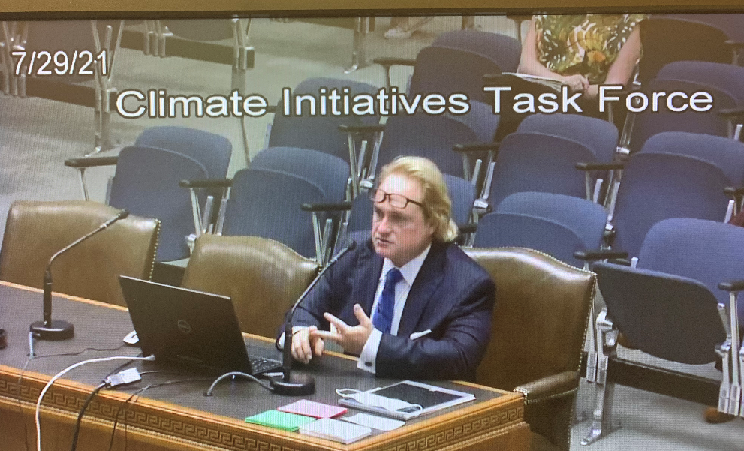
On July 29, Center for Energy Studies Executive Director Professor David Dismukes presented a draft of the updated greenhouse gas (GHG) inventory report to a committee of scientists advising Gov. John Bel Edwards' Climate Initiatives Task Force. The report will serve as a starting point to develop strategies for meeting the governor’s emission reduction goals.
The inventory surveys and provides quantitative estimates of GHG emissions by economic sector using methodologies and modeling established by the Environmental Protection Agency and following guidelines set by the Intergovernmental Panel on Climate Change.
The preliminary findings show:
- 65% of Louisiana’s 2018 GHG emissions come from the industrial sector (138 million metric tons out of 213 million metric tons), half of which are concentrated in the chemical and refining sectors.
- Aggregate industrial GHG emissions have been growing around 1.0% to 1.5% per year over the last seven years. Emissions at the top 20 industrial locations have been growing around 3.5 percent per year.
- Louisiana’s top industrial GHG emission source is the CF Industries plant (~8 million metric tons per year) followed by the ExxonMobil refinery (~6 million metric tons per year).
- Prior to 2008, industrial GHG emissions hovered around 120 million tons per year. Plant expansions appear to have driven this steady state level up to 135 to 140 million metric tons (12.5% to ~17%).
Dismukes is set to deliver the final version of the report in September.
Posted August 23, 2021
Wang Appointed to U.S. EPA Science Advisory Board
LSU Center for Energy Studies Professor, Radiation Safety Office Director, and LSU System Radiation Safety Officer Wei-Hsung Wang was recently invited to serve on the U.S. Environmental Protection Agency (EPA) Science Advisory Board (SAB) and the Radiation Advisory Committee by EPA Administrator Michael E. Regan. According to the EPA’s announcement on August 2, 2021, the SAB will be composed of 22 women and 25 men, including 16 people of color, making it the most diverse SAB since its creation.
The SAB is a chartered Federal Advisory Committee, established in 1978, under the authority of the Environmental Research, Development and Demonstration Authorization Act, to provide independent scientific and technical peer review, consultation, advice, and recommendations to the EPA Administrator. Members of the SAB constitute a distinguished body of non-EPA scientists, engineers, and economists who are nationally and internationally recognized experts in their respective fields. The EPA’s request for nominations to the SAB in April 2021 garnered significant public interest and resulted in 352 candidates representing a cross-section of scientific disciplines.
“It is an honor and privilege to have been selected to serve on the SAB,” Wang said. “I look forward to representing LSU and having the opportunity to work alongside the other members of the Board.”
Wang has served on various advisory capacities for both federal and state government agencies including Louisiana Department of Environmental Quality, Louisiana Department of Health, National Oceanic and Atmospheric Administration, U.S. EPA, and U.S. Nuclear Regulatory Commission. He is a certified health physicist, Fellow of the Health Physics Society, and current Chair of the American Board of Health Physics.
Posted May 3, 2021
Nehiba Analyzes Costs, Benefits of Increasing La. Gas Tax 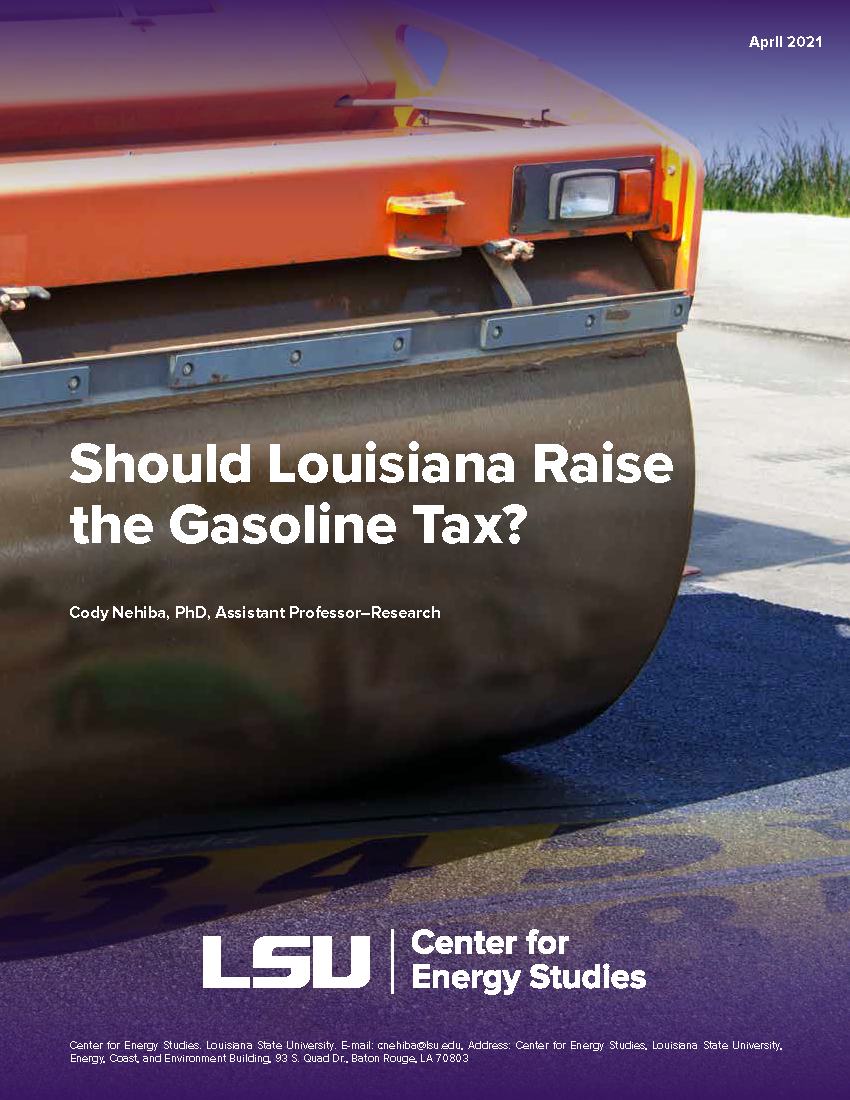
Louisiana has the longest-standing gasoline tax in the nation, logging more than 375 months since it was last changed. Calls to increase the seventh-lowest gasoline tax in the nation to improve road infrastructure appear annually but fail to gain traction. While the state’s citizens enjoy the low $0.20 per gallon tax rate, its benefits are likely offset by the costs of inferior roads, which lead to additional fuel consumption, vehicle damage, congestion, and in some cases, accidents.
In this white paper, CES Assistant Professor Cody Nehiba offers a nontechnical guide to the economic benefits and costs of increasing Louisiana’s gasoline tax. He considers practical implementation options regarding the tax’s equity, revenue usage, and more.
Nehiba notes that gasoline taxes are generally viewed as user fees for roads, funding infrastructure improvements and expansions. Two factors have contributed to the substandard condition of Louisiana’s roads: Inflation has reduced the purchasing power of the current per-gallon tax, and more fuel-efficient vehicles mean that our roads experience more vehicle miles driven, with lower gasoline tax revenues per mile collected.
Critics of increased gasoline taxes argue that the tax could be regressive, disproportionately affecting low-income residents; however, Nehiba points to certain policies, such as revenue-recycling schemes, that could offset those tax burdens.
Another issue of concern is that gasoline taxes do not perfectly align with road usage. “A driver’s total tax burden depends on how much fuel they burn, which is not perfectly correlated with the amount they drive,” Nehiba said. “It’s one reason that it is fair to ask whether we should use gasoline taxes to fund our road infrastructure.”
One option Nehiba examines is a vehicle miles traveled (VMT) tax that charges road users based on how much they actually use roads. VMT taxes are already being tested in other states, including Oregon, which has an opt-in VMT tax that allows drivers to replace their gasoline tax charges with a VMT charge. The system allows Oregon to examine the costs and benefits of a VMT tax on a small scale and examine different technology options.
“Louisiana could benefit from implementing a similar pilot program, potentially getting a ‘head start’ on what very well could be the future of infrastructure funding,” Nehiba said.
Read or download the white paper.
Posted April 30, 2021
Upton Provides Dynamic Score Analysis on House Bill 57
Associate Professor Gregory B. Upton, Jr., prepared a response to a February 10, 2021, request from Louisiana State Representative Jean-Paul Coussan, chair of the House Committee on Natural Resources and Environment, regarding an independent analysis of the impact of House Bill 57 of the 2021 Regular Session. The response includes a dynamic scoring analysis of the economic impact as a result of the proposed severance tax exemption. The analysis includes taxes, licenses, and fees (TLF) collected by state government, but not local governments. Analysis is based on the pre-filed version of HB57, filed on March 4, 2021.
View or download request letter.
View or download the response.
Posted March 25, 2021
Podcast: What Can the U.S. Shale Oil and Gas Boom Teach Economists about Labor Markets?
CES Associate Professor Gregory B. Upton, Jr., prepared a podcast for the International Association for Energy Economics on March 25, 2021. In the podcast, Upton discusses how, over the past decade, the advent of oil and natural gas production from shale geological formations fundamentally changed not only global energy markets but also the communities that reside above these formations. He examines how economists might gain insights from this natural experiment about labor markets and business cycles more broadly.
The discussion was motivated by three working papers:
Listen to the podcast. (Transcript included.)
Posted February 24, 2021
Wang Invited to U.S. EPA Science Advisory Board Review Panel
Dr. Wei-Hsung Wang, professor, Center for Energy Studies, and director, Radiation Safety Office, Louisiana State University, was recently invited to serve on a U.S. Environmental Protection Agency panel charged with reviewing a revision of the Multi-Agency Radiation Survey and Site Investigation Manual, or MARSSIM (Revision 2). MARSSIM provides information on planning, conducting, evaluating, and documenting the building of surface and surface soil radiological surveys used for demonstrating compliance with regulatory requirements. The panel will provide comments on the concepts, methodologies, implementation, presentation, and understandability of the document.
MARSSIM was developed collaboratively by four federal agencies that have authority and control over radioactive materials: Department of Defense, Department of Energy, Environmental Protection Agency, and Nuclear Regulatory Commission.
Wang, who is also the LSU System Radiation Safety officer, is one of 20 panelists, who represent academia (Clemson University, Columbia University, LSU, University of Florida, University of North Carolina, and University of Southern California), government agencies (Lawrence Berkeley National Laboratory, Lawrence Livermore National Laboratory, U.S. Geological Survey, and Washington Department of Health), medical and research institutes (Memorial Sloan-Kettering Cancer Center, Radiation Effects Research Foundation, and University of California Irvine Medical Center), and private industry (DAQ, Inc., Goldin & Associates, M.H. Chew & Associates, Renaissance Code Development, and independent consultants).
“It is an honor and pleasure for me to be involved as panel member to review this detailed guidance document and provide independent advice to the Administrator of EPA in this regard,” Wang said.
Wang has served in various advisory capacities for the Louisiana Department of Environmental Quality, the Louisiana Department of Health, National Oceanic and Atmospheric Administration, and U.S. Nuclear Regulatory Commission. He is a certified health physicist, fellow of the Health Physics Society, and current chair of the American Board of Health Physics.
Posted February 3, 2021
White Paper: Carbon Capture Can Reduce Industrial Tax Burden
A new white paper reveals an approach that Louisiana can use to decrease the burden of a carbon tax on large industrial CO2 emitters. Titled “Overlooked Opportunity: Incentivizing Carbon Capture through Carbon Tax Revenues,” the paper details how carbon tax revenues can advance Carbon Capture Utilization and Storage (CCUS), a technology that reduces CO2 emissions.
A carbon tax, which prices CO2 emissions equal to their environmental damages, is becoming a likely tool for Louisiana and 24 other states as they work to reach net-zero carbon emissions. The white paper, written by LSU Center for Energy Studies Assistant Professor Brittany Tarufelli, reviews the appeal of utilizing carbon tax revenues to fund the research, development, and implementation of CCUS.
“Policymakers have largely overlooked the possibility of recycling carbon tax revenues to incentivize and reduce the costs of CCUS,” said Tarufelli. “This proposition would help emissions-intensive industry and smooth the transition to a lower-carbon economy.”
With global energy consumption forecast to grow 50 percent by 2050, and the industrial sector expected to account for roughly half that growth, industry and policymakers are pressed to address the challenges of meeting rising energy demands while reducing CO2 emissions.
“Advancing CCUS through carbon tax revenues would enable Louisiana’s emissions-intensive industries to meet CO2 reduction goals without drastic cuts in production. This approach would also reduce the tax burden on these industries and ultimately save consumers money,” said Tarufelli.
Read or download the white paper.